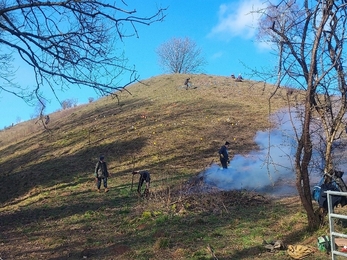Livestock management has been taking up a chunk of time as we look after the existing flocks made up from rare breed sheep including large numbers of Herdwicks, Hebridean and Manx Loughtan, with a few other individuals from other breeds.
The lambs have started to arrive this week with nearly 50 animals expected to be born. We have had a few issues with site visitors impacting the sheep, either with dogs off leads or through direct impact on our fences, which causes the sheep to wander from their designated areas.
The Project with Plantlife to restore a larger population of Pasqueflowers in still ongoing with the second round of direct seeding completing in the autumn with six extra plots at Pegsdon Hills. This Spring will see the Plantlife personnel complete further fingertip searches on the 12 plots to look for germinating seedlings. The first flowers are coming out on the adult plants from the original small population at Pegsdon, and we are hopeful that the coming years will see many more plants in bloom across the site




